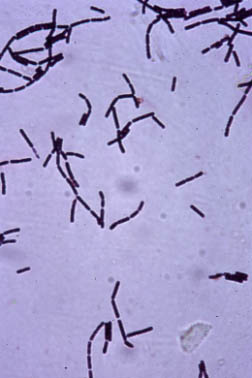Bacillus anthracis is a gram positive rod and is the causative agent of cutaneous, intestinal and inhalational anthrax. Under environmental duress, this organism can form heat and dessicant resistant spores, which allows it to remain viable for a long period of time until it meets a favorable environment. Once it enters a host and becomes vegetative, it's virulence depends on the production of two materials. The first is synthesis of a poly-D-glutamic acid capsule which protects the organism by preventing macrophage phagocytosis. The second is production of the three protein exotoxins: lethal factor, edema factor and protective antigen. B. anthracis' genome consists of an approximately 5.3-MB long chromosome and two plasmids, pXO1(182 kb) and pXO2(96 kb), which contains the genes necessary for producing the two materials. Loss of either plasmid results in a great decrease in infectivity.

gram stain of B. anthracis